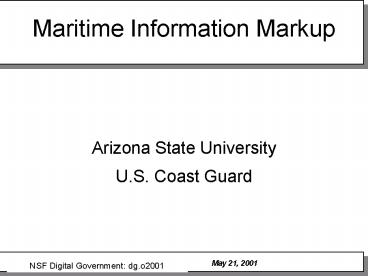Maritime Information Markup - PowerPoint PPT Presentation
1 / 15
Title:
Maritime Information Markup
Description:
... (2)database relations; entry by hand from lexicons and symbology definitions. ... chart database lexicons symbology definitions sample documents ... – PowerPoint PPT presentation
Number of Views:195
Avg rating:3.0/5.0
Title: Maritime Information Markup
1
Maritime Information Markup
Arizona State University U.S. Coast Guard
NSF Digital Government dg.o2001
2
Overview
- Introduction
- Maritime information
- Ontological engineering
- Markup language
- Digital charts and other information
- Prototype demonstration
- Benefits and Summary
3
Maritime Information
- Maritime information is of various types
database, diagrams, pictorial, text, structured,
unstructured. - Charts pictorial depictions based on vector (or
raster) data, with overlays of features' (e. g.,
navigation aids, obstructions). - Text documents describing what the charts cannot
depict, using a structured narrative format. - Port information and port status reports.
- Weather reports and forecasts, warnings, text
messages, updates about navigation aids, etc.
This could be either structured or free form text.
4
Computational Ontology
- In AI, a computational ontology is a
"representation of a conceptualization". It is a
collection of (defined) concepts that exist in a
domain and the relationships between them.
"Computational" means that it can be processed by
software. - Why do we need it? To allow software to
'understand' the relationships between things,
for example, that a 'silo' is (for boaters) a
'landmark. - The knowledge we need comes from standards
documents digital chart databases lexicons and
symbology definitions and other canonical'
documents. - Concepts and relationships are identified by (1)
semi-automated scraping from standards documents
and web sites (2)database relations entry by
hand from lexicons and symbology definitions.
5
Computational Ontology
- Results c. 170 classes from standards, c. 100
from sample digital chart c. 500 from lexicons
and symbology, 30 more from markup. - This is a draft product the number of classes
will change (fall?). - Reuse of other ontologies was explored early on,
but it turned out that not much could be re-used,
largely because the word senses were wrong' for
our domain. For example, a bridge is a passageway
for cars...but a potential obstruction for boats.
6
Taxonomy
7
Markup Language
- Maritime Information Markup Language (MIML) is a
markup language for documents containing maritime
information. - Why do we need it? The documents are densely
packed with information they are
semi-structured linguistic methods are unlikely
to be useful because of the lack of linguistic
clues rarely does anyone need all the
information in a part of a document. - Markup is currently being done by hand.
- How is it being used? Currently, for retrieval.
8
(No Transcript)
9
Digital Chart Data
- What is it?
- Answer Information about individual features.
- What is being done with it?
- Answer Currently, retrieval on demand, soon,
inferences based on values, and distribution. - Other information 'Coast Pilot', weather
forecasts, etc.
10
Putting it all together
- Standards chart database lexicons symbology
definitions sample documents ---gt ontology - Ontology (class and attribute names) ---gt MIML
tags - MIML data retrieval, C P, weather information,
etc. ---gt smarter applications, better
information processing
11
Prototype
- The prototype information retrieval demonstration
that accepts questions and provides answers in
the form of information retrieved from different
sources. The prototype demonstrates the use of
the taxonomy to provide a unified interface for
retrieval of all types of information. - It retrieves information from (1) the Coast
Pilot (2) a feature database generated from
digital nautical charts (3) web sites. It also
generates some information (tide predictions) on
an as-needed basis. - Demonstration this evening.
12
Plans for the Future
- The most important item for research is to feed
the results forward' into other applications. - The most important item for the applications side
is to use the draft ontology and markup in an
effort to create a markup standard for this area.
13
Benefits
- The bulk of United States imports and exports
travel by water. In addition, inland waterways
carry a significant proportion of domestic
freight. - This project will help mariners get more
complete and timely information vital to safety
facilitate development of advanced navigation
aids for coastal navigation software help with
updating base material (e.g., chart databases,
the Coast Pilot) from change notices (e.g., Local
notices to Mariners). - The computer science research aspects impinge
mostly on artificial intelligence, the Semantic
Web and related technology, and geospatial
information.
14
Summary
- This talk has described a 'feed-through' project
consisting of a transition from ontological
engineering to information distribution
technology via markup languages.
15
Culprits
- Raphael Malyankar
- Nicholas Findler
- Leo Leong
- Rashmi Iyengar
- Suresh Lalvani
- Jayagowri Renuka
- Helen Wu
- Jay Spalding, US Coast Guard
- Data supplied by NOAA Maptech
- NSF Digital Govt. program































